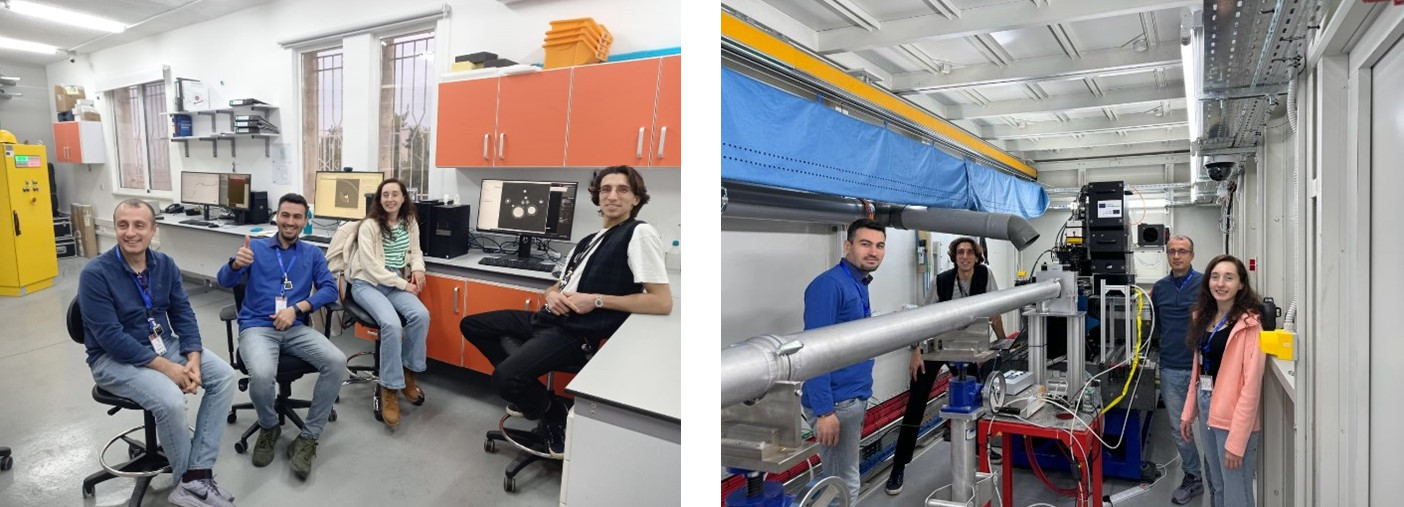In a groundbreaking week, both the ID10-BEATS and the ID11L-HESEB beamlines of SESAME hosted their first group of scientific users.
On February 11, an X-ray computed tomography experiment at BEATS was carried out by a team from Bilkent University UNAM (National Nanotechnology Research Center), in Ankara, Türkiye, consisting of the Principal Investigators Dr. Ali Karatutlu and Dr. Bülend Ortaç, and the PhD Student Ms. Zehra Gizem Mutlay. The group, led by Dr. Karatutlu, focuses on nanotechnology and fiber laser research. Dr. Karatutlu is a renowned expert in laser physics; he expressed excitement about the significant strides made during the experiment and commented “Our team has been dedicated to advancing laser technology, and we are thrilled by the possible breakthroughs that are enabled by this state-of-the-art laboratory”. The measurements began on February 11 and lasted three days, resulting in almost 500 Gigabytes of data, containing 3D pictures of different samples with a voxel size of 650 nanometers. These images can provide insights into the manufacturing and applications of polarization-maintaining fiber glass products.
The day after, February 12, the HESEB beamline also started to host its first user group. It was led by Dr. Yusuf Selim Ocak from the Institute of Nanotechnology at Jordan University of Science and Technology. His collaborators were Dr. Borhan Aldeen Albiss from the same institute and Dr.Bashar Aljawrneh from Al-Zaytoonah University of Jordan. The focus of their research was on metal-oxide semiconductors, and, as expressed by Dr. Ocak “with the help of the HESEB beamline, we can understand the electronic structure of our samples and give answers on the effects of the dopants on the electronic properties of semiconductor thin films”. In three days, Dr. Ocak and his collaborators successfully collected data from 9 samples at 4 different edges.
Through the coming on stream of its 4th and 5th beamline, SESAME, known for its commitment to pushing the boundaries of scientific exploration in the Middle East, has achieved a milestone resulting from intensive collaboration with European research institutes and lightsources.
The ID10-BEATS beamline is the product of the European Horizon 2020 project BEAmline for Tomography at SESAME (BEATS 1) that involved leading research facilities in the Middle East (SESAME and the Cyprus Institute), and European synchrotron radiation facilities ALBA-CELLS (Spain), DESY (Germany), Elettra (Italy), the ESRF (France), INFN (Italy), PSI (Switzerland), and SOLARIS (Poland). The project coordinator, Dr. Axel Kaprolat from ESRF commented: “coordinating the design, construction and commissioning of the BEATS beamline was an extremely satisfying experience, in particular witnessing the extraordinary level of competence and motivation of the SESAME staff. No surprise that the new beamline operates from day one within the expected specifications”.
The ID11L-HESEB beamline was designed, built and commissioned by a consortium of five research centres of the Helmholtz Association of German Research Centres. Professor Wolfgang Eberhardt, scientific head of the HESEB project, added: “I am very happy that this project, which was a joint effort of the Helmholtz centers DESY, HZB in Berlin, HZDR in Rossendorf, FZJ in Jülich and KIT in Karlsruhe in collaboration with SESAME have successfully constructed the first undulator beamline for the soft X-ray range. The performance is as theoretically expected and verified during the commissioning and now we see the first scientific results----congratulations to all who supported this effort”.
These first experiments performed at BEATS and HESEB serve to strengthen the role of SESAME and highlight the facility’s capacity to facilitate scientific breakthroughs. As SESAME’s five beamlines welcome new users, the future holds exciting possibilities for the continued advancement of research and technology at SESAME.


1 BEATS has received funding from the EU’s H2020 framework programme for research and innovation under grant agreement n°822535.

